Dr V McGowan, Prof K Paterson
No more applications being accepted
Funded PhD Project (Students Worldwide)
About the Project
Background
Readers often fail to notice when words are missing or presented of out order, such as we presented the words “out” and “of” in the wrong order in this sentence. Such effects suggest that the language processing system can deal robustly with degraded (i.e., imperfect) input. This poses a challenge to current computational models of reading that are not equipped to deal with degraded input. However, such effects may be explained by more recent “noisy-channel” models that make use of a reader’s knowledge or expectations to resolve imperfections in the linguistic input.
For example, this might mean that readers use their knowledge about word order to determine that a sentence fragment like “presented out of order” is more likely than “presented of out order”, and so perceive the sentence as the former. However, few studies have directly examined whether the noisy-channel theory can be applied to the failure to notice errors during reading.
One further issue that is under-investigated concerns whether this noisy channel processing changes with age. Ageing is associated with visual and cognitive declines (i.e., poorer acuity and slower processing speeds). However, for most people it is also associated with increased exposure to language, which might lead older people to have better language knowledge and stronger linguistic expectations. An important question, therefore, is whether the language processing system adapts in older age to reply more on linguistic expectations to compensate for lower-quality visual input and slower processing.
The aim of the project is therefore twofold: (1) to investigate the cognitive mechanisms that allow us to understand sentences with repeated or omitted words, or words written out of word; (2) to investigate whether this capacity to deal with erroneous linguistic input changes as a function of age and reading experience.
Methods
We can investigate these questions using a combination of online experiments, which enable us to obtain data from many participants quickly and effectively, and more focused laboratory-based experiments using eye movement recordings to provide more detailed insights into the cognitive processes that underpin reading comprehension.
The participants in these experiments will be a combination of young adults (aged 18-30 years), typically recruited from the University, older adults (aged 65+ years), and potentially a broader community sample to allow us to investigate effects of reading experience on noisy channel inferences in reading.
Techniques that will be undertaken during the project:
- Programming of online and eye tracking experiments
- Eye movement recordings during reading
- Creation of stimuli
- Complex statistical analysis using R
BBSRC Strategic Research Priority: Understanding the Rules of Life — Neuroscience and behaviour
Integrated Understanding of Health — Ageing
Start date: 25 September 2023
Entry requirements
- Those who have a 1st or a 2.1 undergraduate degree in a relevant field are eligible.
- Evidence of quantitative training is required. For example, AS or A level Maths, IB Standard or Higher Maths, or university level maths/statistics course.
- Those who have a 2.2 and an additional Masters degree in a relevant field may be eligible.
- Those who have a 2.2 and at least three years post-graduate experience in a relevant field may be eligible.
- Those with degrees abroad (perhaps as well as postgraduate experience) may be eligible if their qualifications are deemed equivalent to any of the above.
- University English language requirements apply
To apply
Carefully read the application advice on our website and submit your PhD application and MIBTP funding form.
https://le.ac.uk/study/research-degrees/funded-opportunities/bbsrc-mibtp

Search suggestions
Based on your current searches we recommend the following search filters.
Check out our other PhDs in Leicester, United Kingdom
Check out our other PhDs in United Kingdom
Start a New search with our database of over 4,000 PhDs

Phonics scope and sequence can be a complicated thing to learn and understand. Find out the exact research-based scope and sequence I use to set students up for reading success.
The number one question I receive via email and social media usually goes something like this:
- What phonics scope and sequence do you use?
- What order do I teach the phonics skills in?
- How do I know what to teach when, and what to teach next?
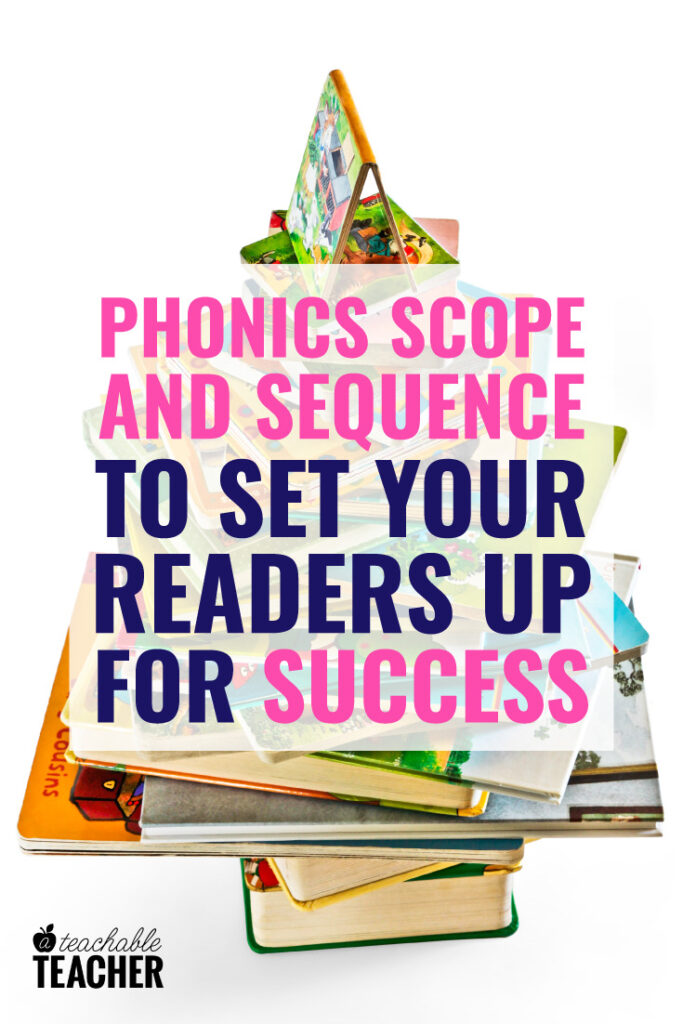
This post contains affiliate links. By purchasing through this link, we get a small commission. Rest assured – we only share links to products that we know and love! Click here to read the full disclosure policy.
Today, I’m answering all of your questions related to phonics scope and sequence.
But First…A Disclaimer My Scope & Sequence
I tweak as I go. I’ve been teaching since 2010, and the order in which I teach phonics has changed since then.
I see what works and what doesn’t work, I try new curriculum recommendations. In addition, I read research and change the way I instruct and assess.
Remember, I’m teachable! 😉 So while this phonics scope and sequence has evolved over time, this is my current best. So it’s not set a stone. Think of it as written in pencil, with the ability to erase!
Phonics should always be taught explicitly and systematically. Yes, there is a general progression of phonics skills that you should follow. I’ve numbered the skills in my list below because it is sequential.
But teaching one of these skills (aside from the alphabet and CVC words) “out of order” is not going to “ruin” your readers forever and ever.”
It’s just going to simplify the process of learning to read if you do use this order.
Phonics Scope & Sequence by Grade Level
I know that many of you are new teachers (welcome, by the way!!) and you will want to know what exact skills you should cover in your specific grade level.
But I can’t answer that for you! (Sorry!!)
I don’t want to lead you astray! I don’t know the exact details of your class or your students, so I can’t give you specifics.
Every school district is different. Every curriculum is different. Every student is different.
Can you see how I would be doing you a disservice if I told you: “You teach first grade, so you much teach this and this.”?
But the Kindergarten teacher at your school didn’t get to CVCe words, and I told you to start with vowel teams….now your students have never been taught CVCe!
So what do you do in the meantime?! Stress that you don’t know where to start?
You could…but that wouldn’t do you any good! 😜
My number one piece of advice for knowing where to start in your grade level is to assess (instead of stress)!
You can use my free Phonics Snapshot Assessment to assess your entire class in 15 minutes or less and know exactly where to begin with your current class!
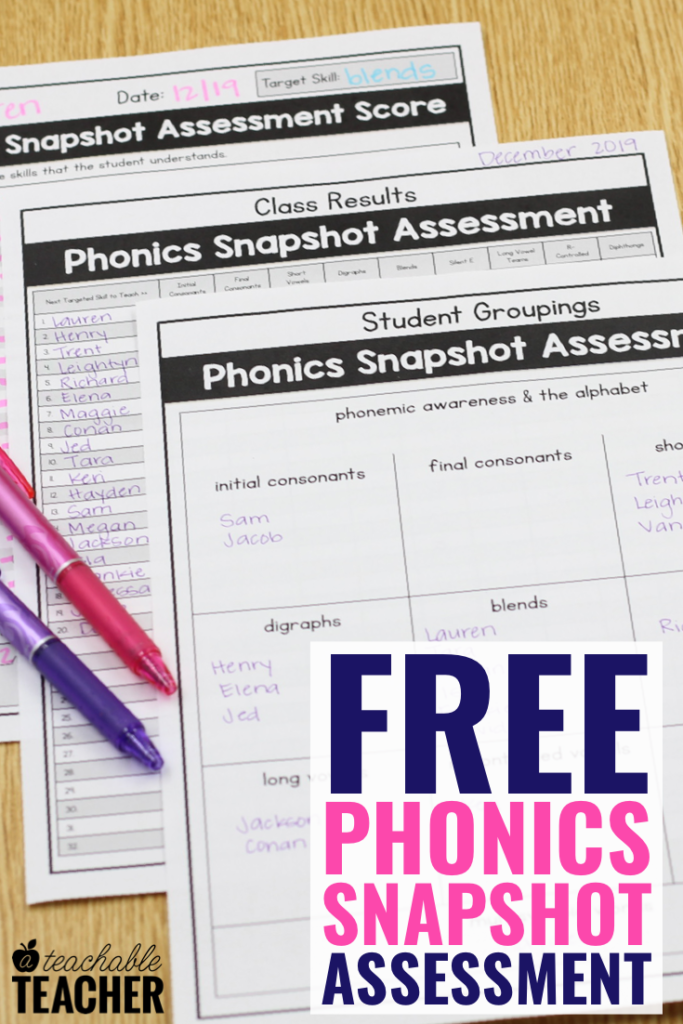
Ok, now that you know this scope and sequence is written in pencil and grade level disclaimers are covered – let’s get started!
1. Phonemic Awareness
Your students can know ALL of the letter sounds and phonics skills in the world, but if they don’t have phonemic awareness, they will not be able to read or spell through phonics.
While I am not going to put “phonemic awareness” next to every skill I’m about to list, I want you to pretend that it’s there!
Seriously, next to each headline, pretend it says “and phonemic awareness” after it! 😂
Practice phonemic awareness every day in your classroom. This is easy to do by incorporating it into the skills that you teach!
For example, if you’re introducing the digraph CH, practice blending and segmenting words with ch before and during your lesson.
I have dozens (upon dozens) of blog posts dedicated to phonemic awareness, which you can find my clicking here.
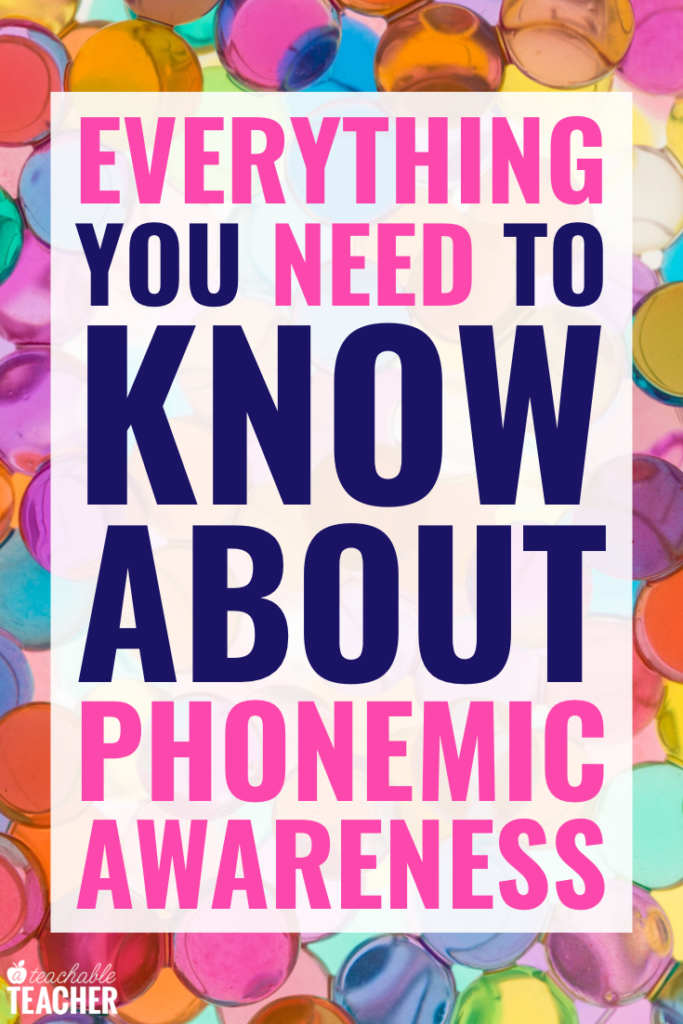
If you want a scripted-for-you guide to teaching phonemic awareness on a daily basis in your classroom in under 15 minutes a day, you’ll want to grab these Phonemic Awareness Teacher Task Cards!
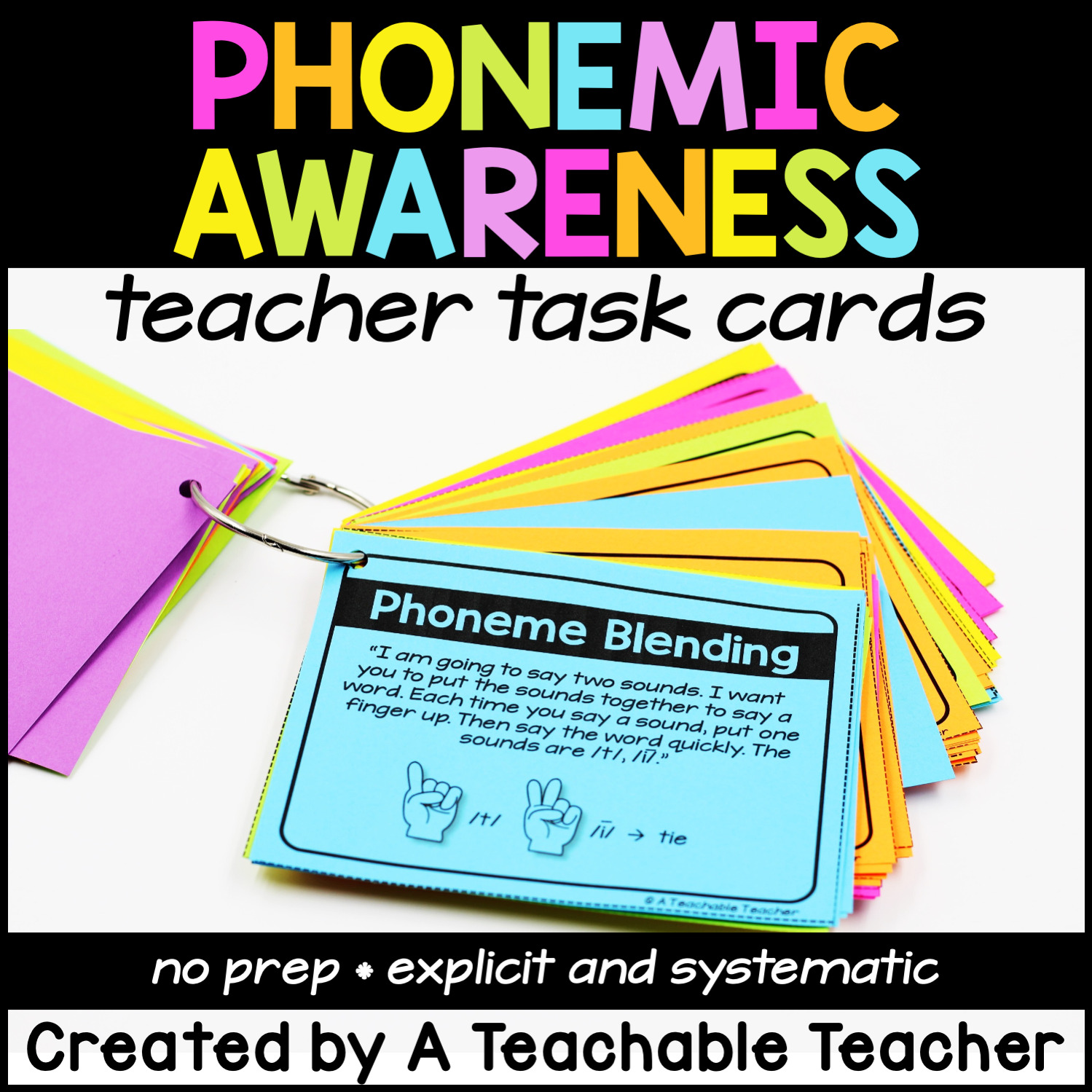
2. The Alphabet
There are soooo many theories about how letter sounds should be taught to students. For instance, letter of the day, letter of the week, introduce all letters in 26 days, alphabet boot camp…
I don’t think there’s one right or wrong way to teach the alphabet as you incorporate the following:
1. Explicitly teach the difference between vowels and consonants
Students should be explicitly taught which letters are consonants and which letters are vowels. So never think that a child is “too young” for this type of vocabulary. It always benefits them in the long run.
2. Teach students a combination of consonants and vowels that allows them to start reading and writing words before learning the entire alphabet
For example
If you teach: c, o, a, and d first, your students can start reading and writing the following (real and nonsense) words:
- ad, cad, dad, cod, doc, etc.
The book Recipe for Reading provides an alphabet scope and sequence and it includes word lists for every step of the way! So I highly recommend it.
Don’t forget, you should be teaching and practicing phonological and phonemic awareness while students are learning the alphabet and now, making and reading words. So without phonological and phonemic awareness, they will be struggling to blend the letters to make words.
3. CVC Words
Once students, (and hopefully while students), have learned the alphabet, they should be practicing reading CVC words.
This includes CVC with all five short vowel sounds (a, e, i, o, u).
- short a) cat
- short e) fed
- short i) kid
- short o) pot
- short u) tub
Remember, if students struggle with reading CVC words but know their letter sounds, the answer is….phonemic awareness. (I hope you’re not sick of me saying that yet, because I’m definitely not done. 🤪)
4. Digraphs
Digraphs are two letters that make one sound.
You should explicitly teach your students the definition of digraphs.
Examples
Start with simple beginning and ending digraphs such as wh, ck, sh, th, and ch.
- wh) white
- ck) duck
- sh) shut
- -sh) wish
- th) that
- -th) bath
- ch) chat
- -ch) reach
Don’t forget to incorporate phonemic awareness activities while learning and practicing words with digraphs!
5. Double Final Consonants
The next skill I teach after digraphs is double final consonants.
Examples
When words with short vowels end in f, l, s, or z, the last consonant is doubled.
This includes words such as:
- -ff) puff
- -ll) fill
- -ss) kiss
- -zz) buzz
6. Blends
Beginning and ending blends can be really tricky for new readers!
I bet you can already predict what I am going to say next….
Be sure to include a LOT of phonemic awareness practice when introducing, teaching, and practicing words with blends!
Beginning Blends
This includes l blends, r blends, and s blends.
Be sure that the words have short vowels since long vowels have been introduced yet.
Here are some examples:
- l blends: blot not bloat
- r blends: pram not prank
- s blends: swat not swine
Beginning 3-Letter Blends (Clusters)
Many s blends and blends with digraphs in them have three letters
Examples
- squ) squid
- scr) scrap
- shr) shrimp
- thr) three
- str) strap
- spr) spring
- spl) splash
Ending Blends
Ending blends can be just as tricky as beginning blends! So be sure to incorporate a lot of phonemic awareness (are you sick of me saying that yet?).
Oh, and don’t forget to make sure that your practice words only include skills that your students have learned!
Here are some examples of ending blends:
- -nd) and
- -nt) tent
- -mp) camp
- -sk) mask
- -sp) wasp
- -st) must
- -lt) melt
- -ld) held
- -lf) elf
- -lp) help
- -ct) insect
- -ft) lift
- -pt) kept
- -xt) text
- -lk) milk
- -nch) crunch
7. Glued Sounds
Glued sounds refer to the skills ng and nk.
I like to teach these as word families. We also practice “chunking” them (or highlighting them) when we see them in words we are decoding.
Examples
- -ng)
- ing) wing
- ang) sang
- ong) tong
- ung) flung
- -nk)
- ink) think
- ank) sank
- onk) honk
- unk) chunk
8. Suffixes
By teaching students basic suffixes (and the “rules” that go along with them), we add to the number of words that students can read.
Examples include:
-s and -es (for plurals)
- dogs
- boxes
-er and -est
- bigger
- biggest
-ed and -ing
- baked
- baking
9. Soft C and Soft G
Remember when I said that this list is numbered but it doesn’t mean you have to follow the exact order?
This is a great example of that! I’ve used curriculums that teach this earlier in the sequence and some that use it later…it’s up to you!
Examples of soft c include:
- cent, dice, race, cell
Examples of soft g include:
- gem, age, stage, huge, magic
10. Long Vowel Sounds
CVCe
Call it CVCe, silent e, or magic e, the real name for this skill be should be “tricky e.”
Learning long vowel sounds and CVCe can really throw young readers for a loop. I recommend incorporating a lot of short vowel VS long vowel practice and CVC vs CVCe practice when learning long vowels.
Examples of CVCe words include:
- long a) save
- long i) ripe
- long o) pole
- long u) tune
I have these FREE CVCe passages available on TpT if you need them!
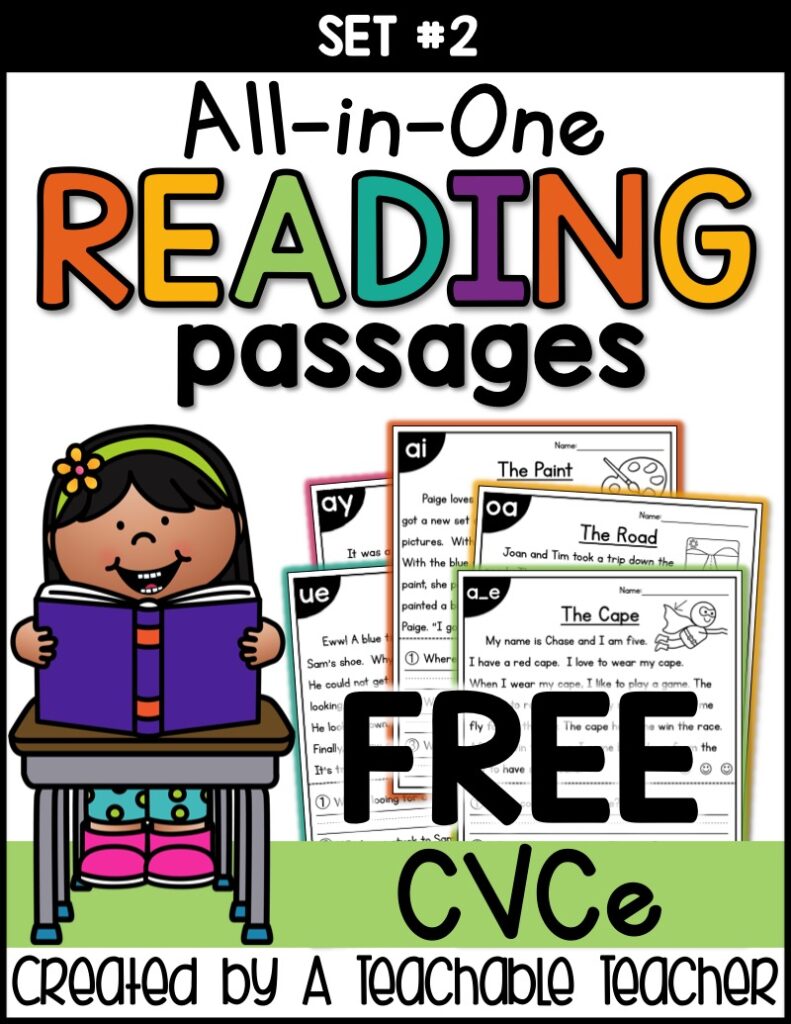
Y as a Vowel
Y can be such an imposter! Yes, I teach my students that vocabulary! Why not? 🤪 They feel smart (because they are!) and it impresses their parents when they use the term. In addition, they’ll never forget what imposter means…or what “y” can do!
Sometimes Y acts as a vowel and takes over as e or i.
Examples of y as a vowel include:
- long e sound) baby, candy, bunny
- long i sound) fly, try, reply
Long Vowel Teams
Note: Some teachers/curriculums teach long vowel teams first, while others teach r-controlled vowels first. I’ve taught it both ways and it hasn’t seemed to make a difference either way.
Examples of long vowel teams include:
- long a) ai, ay
- ai) paint
- ay) hay
- long e) ea, ee
- ea) sea
- ee) feed
- long i) igh, ie
- igh) night
- ie) pie
- long o) oa, oe, ow
- oa) boat
- oe) toe
- ow) bow
- long u) ue, ew
- ue) glue
- ew) few
R-Controlled Vowels
This can also be known as bossy r!
Examples of R-Controlled vowels include:
- basic r-controlled vowels: ar, er, ir, or, ur
- ar) far
- er) feather
- ir) stir
- or) word
- ur) fur
- advanced r-controlled vowels: are, air, ear, our, oar, ore, arr etc.
- are) flare
- air) stair
- ear) bear
- our) flour
- oar) oar
- ore) store
- arr) arrow
Diphthongs
Ahh diphthongs, they have so many names! First of all, did you know that you pronounce it diFthongs? Just in case anyone was wondering… 😂
Some curriculums also refer to them as variant vowels or vowel digraphs.
Diphthongs examples include:
- oi and oy
- oi) point
- oy) boy
- ow and ou
- ow) how
- ou) shout
- au and aw
- au) August
- aw) claw
Suffixes
Once again, teaching students more suffixes “opens the doors” to the amount of words that they can read.
Examples of suffixes include:
- -ly) happily
- -ness) madness
- -ment) movement
- -ful) thankful
- -en) ridden
- -tion) auction
Consonant -le
There are both words with short vowels and words with long vowels that end with a consonant + le, like in the word stable.
These endings include
- -ble) bubble
- -fle) raffle
- -tle) subtle
- -dle) idle
- -gle) juggle
- -kle) crackle
- -ple) staple
- -zle) dazzle
Prefixes
Prefixes come before a word. They carry their own meaning and therefore change the meaning of the word.
Examples of prefixes include:
- un) unkind
- re) remake
- be) become
- mis) mistake
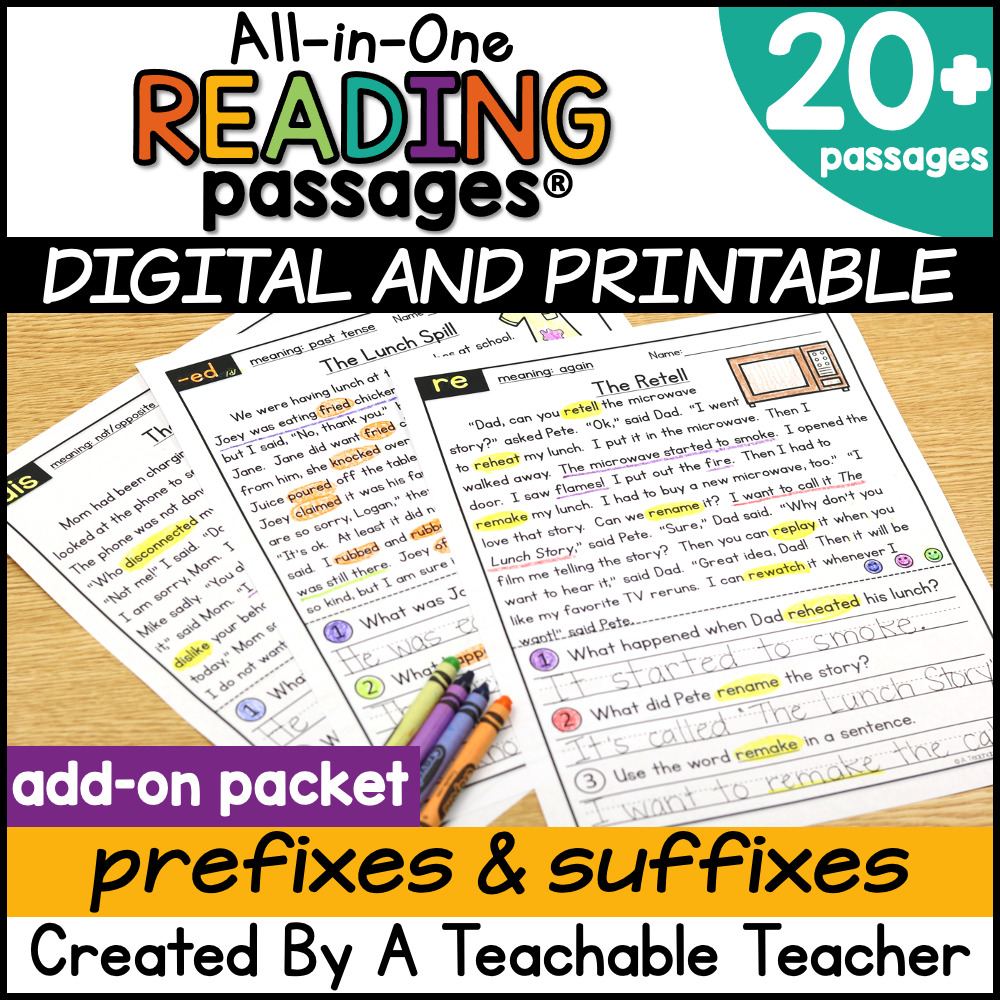
Silent Letters
These are tricky and yet I find that they are rarely (or barely) touched on in primary curriculum!
Examples
Silent letters include letter combinations like lf, lk, mb, wr, kn, and gn.
- lf) shelf
- lk) milk
- mb) climb
- wr) write
- kn) know
- gn) gnat
So…now they should know how to read, right?
Now, now, let’s not get ahead of ourselves.
Just because you’ve taught the scope and sequence once doesn’t mean that all of your students will magically know how to read!
Learning to read is a process that involves many pillars – phonics is just one of them.
You still need to incorporate phonemic awareness, fluency, vocabulary and comprehension. You assess along the way, tweak your instruction, see progress, assess, instruct…and it goes on!
Phonics Scope and Sequence List Download
Are you wishing that all of this information was neatly wrapped up in a list so that you could print it out and reference it?
No worries, I got ya covered. 😉
Enter your name and email below to instantly download all of this in one nice and neat PDF!
(Hey, turn off your pop-up blocker or you might have trouble seeing it!)
So what do you think? Does this scope and sequence differ from what you use to teach phonics? Let me know in the comments below. 👇🏽
More Information on HOW to Teach Phonics
If you’re looking for more information about the process I use to teach phonics, be sure to check this blog post: How Learning to Read is Like Learning to Drive.
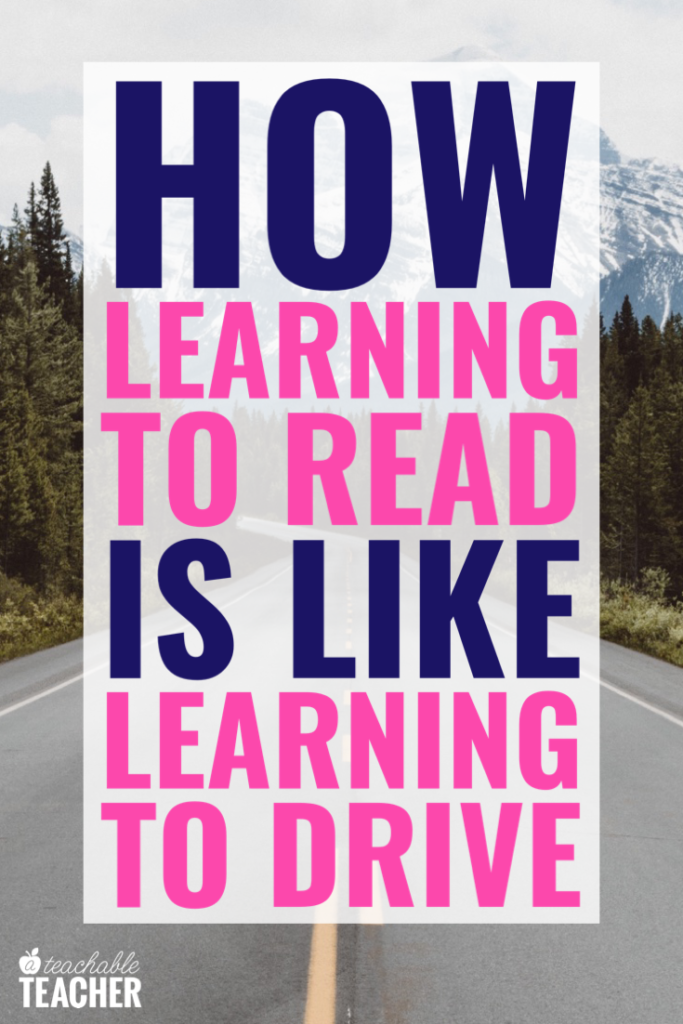
YouTube Videos for Teaching Phonics Skills
I don’t know about you, but my 21st century learners are typically engaged and motivated by videos! So that’s why I’ve taken the time to collect and list YouTube videos for TONS of phonics skills. You can find them all here!
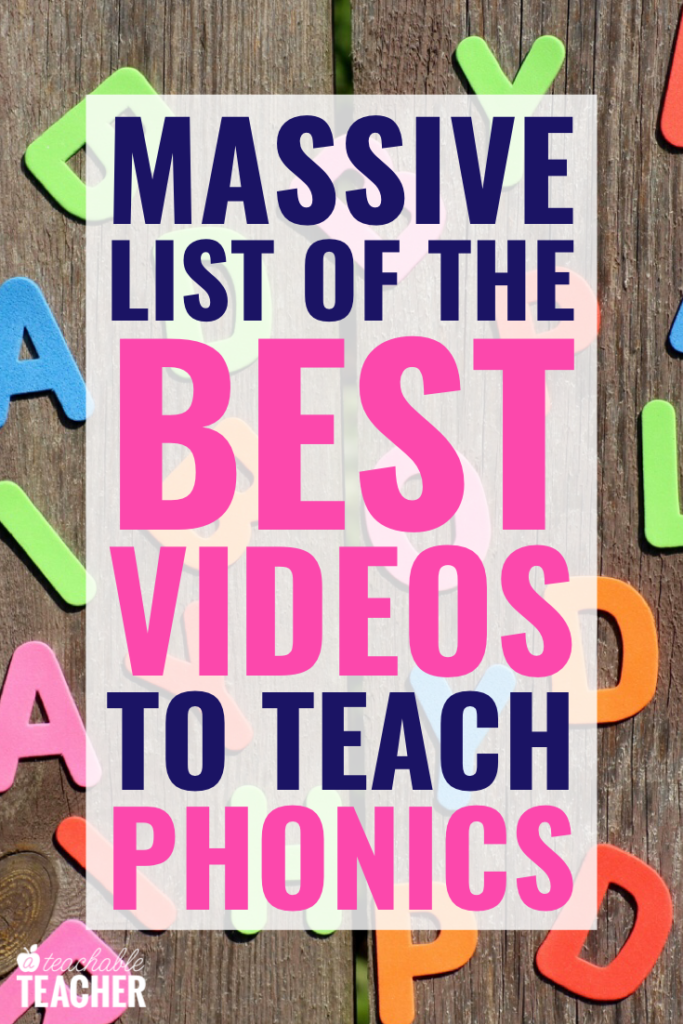
There are two major methods for teaching reading:
-
- “Look-say” or whole language method, where kids memorize the words as one complete structure.
- And phonics method, where children study the correspondence between the sound and the letter and then build up a word out of several phonemes.
The phonics method is known to be the most effective and is widely used in different courses.
Alphabetical or non-alphabetical order?
Most of the course books that I know present the letters in alphabetical order: Aa is for apple, Bb is for ball and so on. But if you teach first Aa, then Bb, then Cc – when do your students start reading?
Sure you can give them meaningless words to read, such as: ab, bab, cab, bac etc.
But children like to achieve quick results and read the words that they can understand.
- I prefer teaching letters in non-alphabetical order.
First Ii, then Tt, Ss, Aa, two letters for 1 lesson.
And here you are, after the first lesson your student can read the word “it” which he already knows, and after the second lesson he can read “It is a…” which is nearly a sentence. Wow!
We created a reading course for Allright.io teachers.
The whole course is based on Microsoft Power Point so you can easily use it during your lessons.
Every lesson consists of the following parts:
1. Revising the letters that are already known.
2. A game for revising the letters.
3. Presenting a new letter (2 letters at a time for the first 4 lessons).
4. A game for learning the letter.
5. Reading words with the letter.
6. Reading short texts.
Try teaching your students with this course and you will see guaranteed results.
You can download this course here: https://drive.google.com/drive/u/3/folders/1PFXLMK-HdJlIh82ARQ0U7nSA3GSebPON
Or use it online: https://allright.io/blog/2017/10/04/letters-and-reading/
